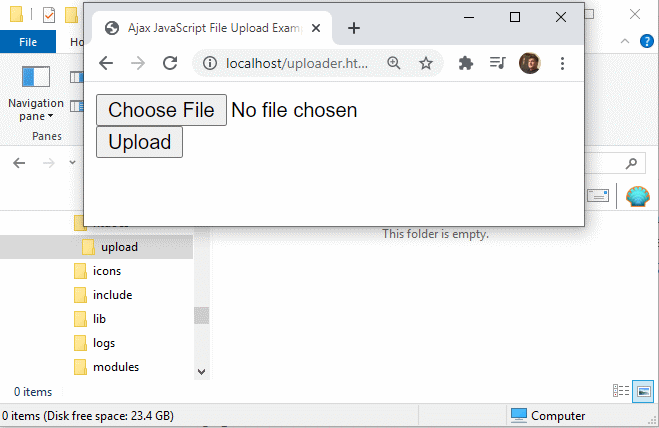Javascript Upload File to Php Using Ajax
Note, this article deals with customer-side JavaScript. For a client and server-side JavaScript upload example, check out this File Uploads with Node and JavaScript tutorial.
It used to be a daunting claiming for a developer to upload files through a browser. Poor client-side facilities hampered the equation, and server-side components needed to exist to handle the incoming data stream.
Fortunately, HTML5 file input course tags simplified things on the client side. However, developers take added needless complexity to their application when it comes to creating Ajax and JavaScript file uploads. When developers plow to popular libraries such as jQuery or Dojo Toolkit, they add together unnecessary bug to file uploads. Thankfully, at that place is an easier way.
| More File Upload Options |
|---|
| I put together a bunch of file upload tutorials. Option your technology and get uploading!
Uploading files to the server demand not exist a problem. |
The easiest and simplest way for a developer to accomplish an Ajax file upload is to use pure JavaScript and get out the bulky libraries and frameworks behind.
Ajax file uploads
A developer tin perform an Ajax-based file upload to a server with JavaScript in five steps:
- An HTML5 input course element must be included in the webpage that renders in the client'south browser;
- A JavaScript method must be coded to initiate the asynchronous Ajax based file upload;
- A component must exist on the server to handle the file upload and salve the resource locally;
- The server must ship a response to the browser indicating the JavaScript file upload was successful; and
- The customer's browser must provide an Ajax-based response indicating the file uploaded successfully.
In this example, the JavaScript file upload target is an Apache Spider web Server. As a result, the server-side component that handles the Ajax asking will be written in PHP. If a Tomcat or Jetty server was the upload target, a developer could code a Java based uploader on the server-side.
HTML5 file tags
HTML5 introduced a new blazon of input class field named file. When a browser encounters this tag, it renders a fully functional file picker on the web page. When it's combined with an HTML5 button tag that tin trigger a JavaScript method, these two elements stand for the required markup elements to brainstorm the JavaScript and Ajax file upload process.
The following HTML5 tags provide the required components to add together a file selector and an upload button to any web folio:
<input id="fileupload" type="file" proper name="fileupload" /> <push button id="upload-button" onclick="uploadFile()"> Upload </push>
The push kicks off a method named uploadFile(), which contains the JavaScript file upload logic.
<script> async office uploadFile() { allow formData = new FormData(); formData.append("file", fileupload.files[0]); await fetch('/upload.php', { method: "Postal service", body: formData }); alert('The file has been uploaded successfully.'); } </script>
JavaScript file upload logic
The above script tag contains nothing but pure JavaScript. In that location's no jQuery or Dojo thrown into the mix and the logic is straightforward:
- Create a FormData object to incorporate the information to be sent to the server;
- Add together the chosen file to be uploaded to the FormData object;
- Asynchronously call server-side resource to handle the upload; and
- The server-side resource is invoked through the Postal service method
- The server-side resources is passed the FormData which contains the file
- In this example that server-side resource is named upload.php
- When notified that the JavaScript file upload was successful, send an Ajax based alert to the customer.
All the HTML and JavaScript logic will be contained in a single file named uploader.html. The complete HTML looks equally follows:
<!DOCTYPE html> <html> <head> <title> Ajax JavaScript File Upload Example </title> </head> <body> <!-- HTML5 Input Form Elements --> <input id="fileupload" type="file" name="fileupload" /> <button id="upload-push button" onclick="uploadFile()"> Upload </push button> <!-- Ajax JavaScript File Upload Logic --> <script> async part uploadFile() { let formData = new FormData(); formData.append("file", fileupload.files[0]); wait fetch('/upload.php', { method: "Postal service", trunk: formData }); alert('The file has been uploaded successfully.'); } </script> </body> </html>
Apache file upload processing

Required JavaScript file upload components.
When an asynchronous JavaScript file upload happens, a server-side component must exist to handle the incoming file and store information technology. Since this example uses an Apache HTTP Server (AHS), and since PHP is the linguistic communication of AHS, information technology requires a file named upload.php that contains a small PHP script to relieve the incoming file to a folder named uploads:
<?php /* Get the name of the uploaded file */ $filename = $_FILES['file']['name']; /* Choose where to save the uploaded file */ $location = "upload/".$filename; /* Save the uploaded file to the local filesystem */ if ( move_uploaded_file($_FILES['file']['tmp_name'], $location) ) { echo 'Success'; } else { echo 'Failure'; } ?>
The PHP script is besides straightforward. Information technology obtains the name of the file being uploaded, and then creates a spot in a folder named upload to save the file. PHP'southward move_uploaded_file method is so used to save the uploaded file to this new location.
Run the JavaScript file upload instance
The files used in this example, forth with a folder named upload, must be added to the htdocs folder of AHS. When a client accesses the uploader.html file through a browser, the client volition be able to upload a file to the server using Ajax and pure JavaScript.

A pure JavaScript file uploader simplifies Ajax based interactions with the server.
Source: https://www.theserverside.com/blog/Coffee-Talk-Java-News-Stories-and-Opinions/Ajax-JavaScript-file-upload-example
0 Response to "Javascript Upload File to Php Using Ajax"
Post a Comment